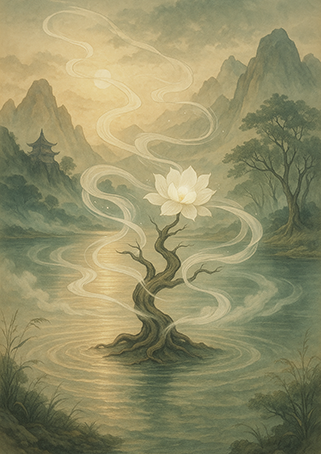Xieyi・The Rootless Tree:100 Verses-Verse 58#366

The poems of “The Rootless Tree” express a fundamental force rooted in harmony with heaven and earth, the cyclical flow of yin and yang, and the infinite potential of existence。
This painting is an expressive “Xieyi” in the tradition of “futu” (spiritual diagrams), passed down for generations in Wudang Mountain, China. It is drawn through a technique where energy flow (xingqi) channels the internal intention into visual form。 In the Taoist world, there exist spiritual and symbolic images called “futu”。
In the Taoist world, there exist spiritual and symbolic images called “futu”。
These are a type of talisman—not merely religious items, but expressive spiritual paintings that act directly on the mind of the viewer。
Since ancient times, many people have placed these Taoist-style “Xieyi” and futu in their homes, studies, or bedrooms, wishing for longevity, health, auspiciousness, and family harmony. Viewing such paintings was not just aesthetic appreciation, but an act of inviting the presence of the Dao into one’s life and tuning the body and mind。
Thus, “Xieyi” is more than artistic expression—it is a medium that bridges the spirit, life, and harmony with the universe。
This kind of artwork is not meant to be seen only with the eyes, but felt with the heart。
It communicates with the Dao, resonates with the qi of nature, and quietly stirs the viewer’s inner self。
Futu and “Xieyi” continue to live on from ancient times to this day as “sacred images that speak to the soul.”
Below, we present the original text of the philosophical poem “The Rootless Tree,” along with a modern Japanese translation and interpretation。
※ The author of “The Rootless Tree,” Zhang Sanfeng (1247–?), is also renowned as the founder of Tai Chi, and it is said that he applied the essence of this work to Tai Chi. As an additional note, we include an interpretation connecting this to the Tai Chi tradition of Wudang Mountain.
The Rootless Tree・Verse 58

▶Original Text
無根樹,花正白,行止無常,隨氣運行。陰陽變化,氣無窮無盡,無為而無所不成。
▶Modern Translation
A white flower graces the rootless tree.
Movement and stillness shift with qi’s direction.
Yin and yang forever change; qi circulates endlessly.
Without striving, all comes to completion.
▶Interpretation
[無根樹,花正白] White—purity, emptiness, and origin.[行止無常,隨氣運行] Move or pause with qi—not fixed.
[陰陽變化,氣無窮無盡] Yin-yang change—qi never ends.
[無為而無所不成] Non-doing achieves everything.
▶Interpretation related to Tai Chi
Purity through unattached practice.
Let movement flow from qi’s impulse.
Understand transformation, not resistance.
Non-effort as the highest art.
Copyright © MASAKI WAKABAYASHI. All rights reserved.




